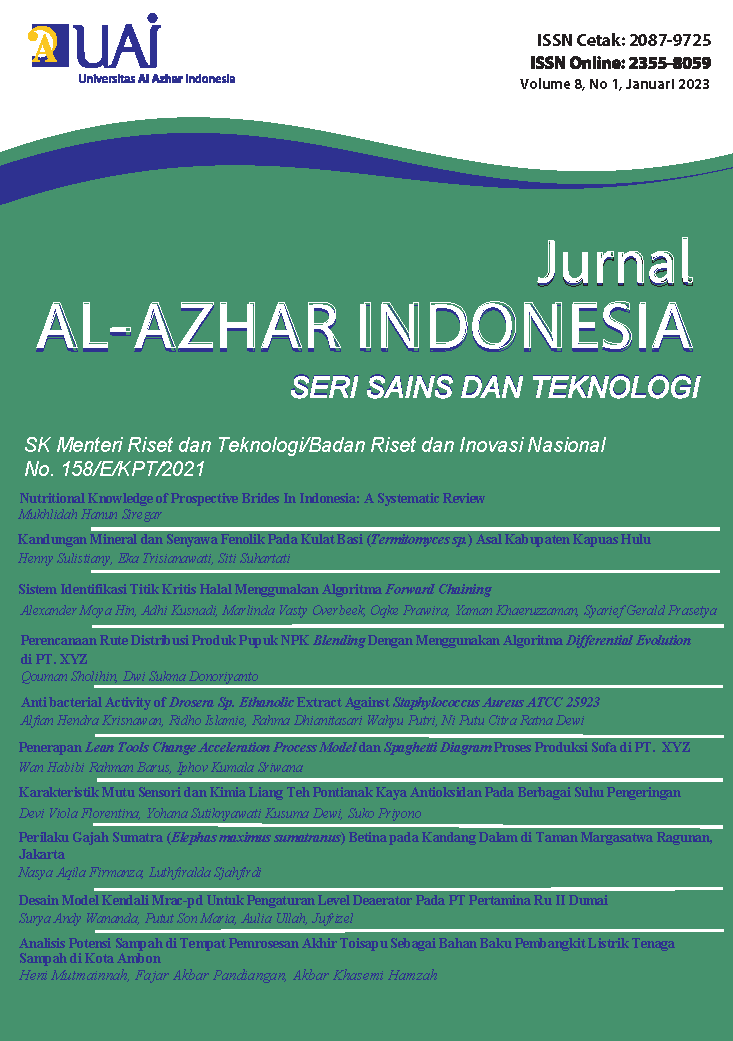Antibacterial Activity of Drosera Sp. Ethanolic Extract Against Staphylococcus Aureus ATCC 25923
DOI:
https://doi.org/10.36722/sst.v8i1.1494Abstract
Drosera sp. is an insectivorous plant with secondary metabolites, including naphthoquinones which can be used as antibacterial agents. Staphylococcus aureus is a bacterium that often causes nosocomial infections, such as ARI. This research aims to determine the antibacterial activity of four Drosera species, namely D. burmannii, D. sessilifolia, D. capillaris, and D. filiformis, against Staphylococcus aureus ATCC 25923. The agar diffusion method was employed in antibacterial testing by measuring the inhibition zone. The inhibition zone measured using a 7,000 ppm concentration of Drosera sp. ethanolic extract was 6.74 ± 0.21 mm, 9.21 ± 0.32 mm, 18.18 ± 0.60 mm, and 15.67 ± 0.37 mm for D. burmannii, D. sessilifolia, D. capillaris, and D. filiformis, respectively. The largest value was produced by D. capillaris which was close to 19.73 ± 0.55 mm from the positive control (chloramphenicol). The four Drosera sp. extracts have antibacterial potential against Staphylococcus aureus ATCC 25923.
Keywords – Antibacterial activity, Drosera sp., Staphylococcus aureus
References
M. A. Akindolire, O. O. Babalola, and C. N. Ateba, “Detection of antibiotic resistant Staphylococcus aureus from milk: A public health implication,†Int J Environ Res Public Health, vol. 12, no. 9, pp. 10254–10275, Aug. 2015, doi: 10.3390/ijerph120910254.
A. Fusvita and A. Umar, “Identifikasi Bakteri Pernafasan Penyebab Infeksi Saluran Pernafasan (ISPA) Pada Usia Balita di Rumah Sakit Bahteramas,†Jurnal Analis kesehatan Kendari, vol. 1, no. 1, pp. 40–46, 2016.
Ministry of Health of the Republic of Indonesia, “Laporan Nasional Riskesdas 2018,†Jakarta, 2018.
P. A. Egan and F. van der Kooy, “Review - Phytochemistry of the Carnivorous Sundew Genus Drosera (Droseraceae) - Future Perspectives and Ethnopharmacological Relevance,†Chem Biodivers, vol. 10, pp. 1774–1790, 2013, doi: 10.1002/cbdv.201200359.
B. Baranyai, C. Bäcker, C. Reich, and U. Lindequist, “The production of 7-methyljuglone, plumbagin and quercetin in wild and cultivated Drosera rotundifolia and Drosera intermedia,†Mires and Peat, vol. 18, 2016, doi: 10.19189/MaP.2016.OMB.228.
R. Ravee, F. I. M. Salleh, and H. H. Goh, “Discovery of digestive enzymes in carnivorous plants with focus on proteases,†PeerJ, 2018, doi: 10.7717/peerj.4914.
G. Dileep Kumar, C. D. S. L. N. Tulasi, and G. Ramakrishnaiah, “Phytochemical screening and evaluation of in vitro antimicrobial activity of drosera spatulata var. Bakoensis - An indigenous carnivorous plant against respiratory tract infectious microbes,†Asian Journal of Pharmaceutical and Clinical Research, vol. 9, no. 6, pp. 274–283, Nov. 2016, doi: 10.22159/ajpcr.2016.v9i6.14382.
R. Goswami, T. Sinha, and K. Ghosh, “Drosera Sp: A Critical Review on Phytochemical and Ethnomedicinal Aspect,†International Journal of Pharmacy and Biological Sciences-IJPBS TM, no. 1, p. 9, 2019, doi: 10.21276/ijpbs.2019.9.1.76.
D. ÄŽurechová, M. KaÄániová, M. Terentjeva, J. Petrová, L. Hleba, and I. Kata, “Antibacterial Activity of Drosera Rotundifolia L. Against Gram-Positive and Gram-Negative Bacteria,†Journal of microbiology, biotechnology and food sciences, vol. 5, no. special 1, pp. 20–22, Feb. 2016, doi: 10.15414/jmbfs.2016.5.special1.20-22.
M. KaÄániová et al., “Antimicrobial Activity of Drosera rotundifolia L,†Scientific Papers: Animal Science and Biotechnologies, vol. 47, no. 2, pp. 366–369, 2014.
M. Krychowiak et al., “Combination of Silver Nanoparticles and Drosera binata Extract as a Possible Alternative for Antibiotic Treatment of Burn Wound Infections Caused by Resistant Staphylococcus aureus,†PLoS One, vol. 9, no. 12, Dec. 2014, doi: 10.1371/journal.pone.0115727.
D. K. Biswal, S. Yanthan, R. Konhar, M. Debnath, S. Kumaria, and P. Tandon, “Phylogeny and biogeography of the carnivorous plant family Droseraceae with representative Drosera species from Northeast India,†F1000Res, vol. 6, no. 1454, Aug. 2017, doi: 10.12688/f1000research.12049.1.
N. B. Ghate, D. Chaudhuri, A. Das, S. Panja, and N. Mandal, “An Antioxidant Extract of the Insectivorous Plant Drosera burmanii Vahl. Alleviates Iron Induced Oxidative Sress and Hepatic Injury in Mice,†PLoS One, vol. 10, no. 5, 2015.
D. M. Septy, T. Saptawati, and F. A. Rachma, “The Anatomical Characteristic, Phytochemical Screening and Antioxidant Activity Test of Drosera capillaris Herbs Using the FRAP Method,†in Prosiding Seminar Nasional UNIMUS, 2021, pp. 1272–1280.
Susanty and F. Bachmid, “Perbandingan Metode Ekstraksi Maserasi dan Refluks Terhadap Kadar Fenolik dari Ekstrak Tongkol Jagung (Zea mays L.),†JURNAL KONVERSI, vol. 5, no. 2, pp. 87–93, Oct. 2016, doi: 10.24853/konversi.5.2.87-92.
E. Gayathiri, B. Bharathi, and K. Priya, “Study of the Enumeration of Twelve Clinical Important Bacterial Populations at 0.5 McFarland Standard,†International Journal of Creative Research Thoughts (IJCRT), vol. 6, no. 2, pp. 880–893, 2018.
H. Manurung, R. Agung Nugroho, and E. Marina, “Phytochemical Screening and Antibacterial Activity of Leaves Extract Balangla (Litsea cubeba (Lour) Pers.) from Malinau, East Borneo,†in Proceeding of 5th International Seminar on New Paradigm and Innovation on Natural Sciences and Its Application (5th ISNPINSA), 2015, pp. 5–8.
C. Onyebuchi and D. Kavaz, “Effect of extraction temperature and solvent type on the bioactive potential of Ocimum gratissimum L. extracts,†Sci Rep, vol. 10, no. 1, Dec. 2020, doi: 10.1038/s41598-020-78847-5.
Ministry of Health of the Republic of Indonesia, “Farmakope Herbal Indonesia edisi II,†Jakarta, 2017.
W. S. Rita, I. M. D. Swantara, I. A. R. A. Asih, and N. K. Sinarsih, “Antibacterial Activity of Samanea saman Leaf Ethanol Extract Against Escherichia coli and Staphylococcus aureus and its Total Flavonoid And Phenolic Contents,†Jurnal Kimia, vol. 12, no. 2, pp. 121–127, 2018.
P. A. Singh and N. Bajwa, “Future Perspectives of Drosera Magnifica: The First Ever Plant Discovered on The Social Media,†Journal of Drug Delivery and Therapeutics, vol. 7, no. 4, pp. 12–19, Jul. 2017, doi: 10.22270/jddt.v7i4.1474.
Y. Xie, W. Yang, F. Tang, X. Chen, and L. Ren, “Antibacterial Activities of Flavonoids: Structure-Activity Relationship and Mechanism,†Curr Med Chem, vol. 22, no. 1, pp. 132–149, Sep. 2014, doi: 10.2174/0929867321666140916113443.
A. Trisia, R. Philyria, and A. N. Toemon, “Uji Aktivitas Antibakteri Ekstrak Etanol Daun Kalanduyung (Guazuma ulmifolia Lam.) Terhadap Pertumbuhan Staphylococcus aureus dengan Metode Difusi Cakram (Kirby-Bauer),†Anterior Jurnal, vol. 17, no. 2, pp. 136–143, 2018.
Y. E. Lee, J. H. Lee, Y. K. Lee, B. H. Lee, J. S. Kim, and H.-J. Lee, “ A Study on Single-dose Toxicity and Repeated-Dose Toxicity of Drosera Rotundifolia L . Pharmacopuncture in Rodent Models ,†Korean Journal of Acupuncture, vol. 36, no. 2, pp. 127–138, Jun. 2019, doi: 10.14406/acu.2019.013.

